#andrea capellanus
Explore tagged Tumblr posts
Text
hmmm....
I saw some posts about A/G/L and how Camelot could have been saved...
And I personally thought "the medieval writers already dismissed the polyamory argument centuries before"
Its in Andreas Capellanus' Art of Courtly Love/De Amore:
"No one can be bound by Double Love/two Loves"
Which means "Pairings only" - both partners in a romantic couple can only have eyes for a singular person, whom they have an intense, health ruining affection for. There's no room for another person, because otherwise, it dilutes the tension and intensity of the romantic fiction for the audience, making it seem like the lover/beloved is a two-timer or weak and indecisive.
The argument goes "If you're not 100% for that one person, how can you say you are truly in deep love with that one person?"
My two cents is: Lancelot has two hands but only one heart.
This is probably why Galehaut exists: to prove Lancelot's status as a True Lover, he will always singularly choose Guinevere and her love over anything else.
It doesnt help there's other rules that say the (male) lover has to be jealous and possessive of the (female) beloved.
EDIT: There is another rule that enforces the "One Love Interest Only" Principle:
"The True Lover never desires the embraces of any save that of his lover"
#a/g/l#polyamory#courtly love#king arthur#sir lancelot#queen guinevere#andrea capellanus#marie de champagne#art of courtly love#de amore#arthuriana#arthurian legend#arthurian mythology#arthurian legends#my thoughts
7 notes
·
View notes
Text
The Rules of Courtly Love
as relayed by the King of Love, in a long allegory within a dialogue between a nobleman and a noblewoman where he is mansplaining why she should sleep with him, thank you Andreas Capellanus:
Rule I: "Thou shalt avoid avarice like the deadly pestilence and shalt embrace it's opposite": A strong start. No objections here.
Rule II: "Thou shalt keep thyself chaste for the sake of her whom thou lovest". Look if it weren't self-denying and a little perhaps contradictory it wouldn't be courtly love
Rule III: "Thou shalt not knowingly strive to break up a correct love affair that someone else is engaged in." My affair with your wife is none of your damn business
Rule IV: "Thou shalt not choose for thy love anyone whom a natural sense of shame forbids thee to marry." A real can of worms wrigging around in this one, we'll just fly on by to:
Rule V: "Be mindful completely to avoid falsehood." Good fucking luck with that
Rule VI: "Thou shalt not have many who know of thy love affair." BE COOL
Rule VII: "Being obedient in all things to the commands of ladies, thou shalt ever strive to ally thyself to the service of Love." Do what she tells you, man
Rule VIII: "In giving and receiving love's solaces let modesty ever be present." Lights off, I guess?? Hands behind your back and eyes closed?? Good luck and godspeed
Rule IX: "Thou shalt speak no evil." Snitches get stitches
Rule X: "Thou shalt not be a revealer of love affairs." I SAID, SNITCHES get STITCHES
Rule XI: "Thou shalt be in all things polite and courteous." Sure. Fine. Good advice for us all, I suppose
Rule XII: "In practicing the solaces of love thou shalt not exceed the desires of thy lover." No, I meant it up there, seriously, do what she tells you, man
Anyway what more romantic advice could anyone possibly need? I think this covers all the bases, good luck following your heart and other associated organs in Troyes c. 1170
42 notes
·
View notes
Text
Marriage is no real excuse for not loving.
He who is not jealous, cannot love.
No one can be bound by a double love.
It is well known that love is always increasing or decreasing.
That which a lover takes against the will of his beloved has no relish.
Boys do not love until they arrive at the age of maturity.
When one lover dies, a widowhood of two years is required of the survivor.
No one should be deprived of love without the very best of reasons.
No one can love unless he is impelled by the persuasion of love.
Love is always a stranger in the home of avarice.
It is not proper to love any woman whom one would be ashamed to seek to marry.
A true lover does not desire to embrace in love anyone except his beloved.
When made public love rarely endures.
The easy attainment of love makes it of little value; difficulty of attainment makes it prized.
Every lover regularly turns pale in the presence of his beloved.
When a lover suddenly catches sight of his beloved, his heart palpitates.
A new love puts to flight an old one.
Good character alone makes any man worthy of love.
If love diminishes, it quickly fails and rarely revives.
A man in love is always apprehensive.
Real jealousy always increases the feeling of love.
Jealousy, and therefore love, are increased when one suspects his beloved.
He whom the thought of love vexes eats and sleeps very little.
Every act of a lover ends in the thought of his beloved.
A true lover considers nothing good except what he thinks will please his beloved.
Love can deny nothing to love.
A lover can never have enough of the solaces of his beloved.
A slight presumption causes a lover to suspect his beloved.
A man who is vexed by too much passion usually does not love.
A true lover is constantly and without intermission possessed by the thought of his beloved.
Nothing forbids one woman being loved by two men or one man by two women.
44 notes
·
View notes
Text
De amore by Andreas Capellanus, a satirical text written in the same court as The Knight of the Cart
…one kind of love is pure, and one is called mixed. It is the pure love which binds together the hearts of two lovers with every feeling of delight. This kind consists in the contemplation of the mind and the affection of the heart; it goes as far as the kiss and the embrace and the modest contact with the nude lover, omitting the final solace, for that is not permitted to those who wish to love purely.
I am so here for courtly love fingering satire.
5 notes
·
View notes
Text

❦ THE ART OF COURTLY LOVE
cw: mature, suggestive content, otherwise fluff

“have you ever read andreas capellanus, ‘the art of courtly love’?”
you turn in your chair, moving from looking at yourself in your vanity mirror to your boyfriend sitting on your shared bed.
you smile slightly.
“i’m sure you know the answer.” you take a quick look up and down at him—spencer definitely was not as dressed as he should be for dinner at rossi’s.
“he was inspired by his love to write a book.” he says, holding soft eye contact. “he says that love is suffering, because you desire the person yet do not have them.”
he holds out his hands to you.
you obey the silent ask and get up to walk towards him, placing your hands in his as he pulls you to stand between his legs.
your fingers come to rest on his shoulders as he protectively holds your hips.
“he says that this love inspires men to act more chivalrous—more courteous.” he continues.
your fingers run through his hair gently, and his eyes close in bliss for a moment.
“and you are the epitome of chivalry.” you tell him and his eyes open with a hard look.
“not when you wear that outfit.”
you raise your eyebrow at him, his hands bring you closer to his body as he looks at you with clouded eyes of lust.
“we can be a little late to rossi’s.” he whispers, hands trailing lower.
“is this what you intended when you bought me this outfit?” you asked rhetorically. “and is ‘the art of courtly love’ just a pick up line?”
“only the finest art can stand in the face of beauty such as yourself.” he gently pulls you down face to face.
“and who said that?” you whisper with a smile.
“me.” he says and kisses you softly.
you climb on top of his lap, allowing his lips to praise your face. his hands roam your body like they have a million times, but it always gets you riled up like the very first time.
you break away.
“we can be a little late.”

#criminal minds#criminal minds imagine#criminal minds fluff#criminal minds x reader#spencer reid x y/n#spencer reid x you#spencer reid imagine#spencer reid fluff#spencer reid x reader#spencer reid
606 notes
·
View notes
Note
did you catch criston asking alicent for her favor? would he be allowed to do that in front of their brother? isn't it a giveaway that they're having an affair? what's the rules for that?
Not at all, anon! What Criston did is all well and good within the rules of medieval courtly love.
(If you want to learn more about courtly love, I recommend De Amore by Andreas Capellanus for a straightforward dialogue on its rules. Also look up the works of Chrétien de Troyes who was specifically comissioned to write about the romances of the Arthurian court.)
A lady's favor isn't necessarily an indicator of romantic interest. A lot of the rules of courtly love are built on plausible deniability, so a favor could be interpreted as just that — a lady blessing a knight so that they may succeed in battle.
There's been some debate over whether Criston was out of line since knights don't usually ask ladies for their favor outside of hastiludes. In actual war, some ladies will still offer but it's a bit uncouth for the knight to ask for one given that there's a much higher likelihood that he won't return it given that....you know, war is more dangerous than a tourney.
And yes, a lot of ladies do expect the knight to return their favor once the battle is over. In the show, Alicent gave Criston a handkerchief which probably isn't that valuable to a queen like her, but that isn't the case for a lot of ladies. Aside from handkerchiefs, they would give ribbons and detached sleeves they sewed or embroidered themselves. That's hours and hours and hours of hand-stitching without modern machinery. They can also give pieces of jewelry like the bracelet Rhaenyra gives Criston in the first episode, and I'd definitely want something like that back if I wasn't a super rich princess.
That's why ladies just didn't give favors out like candy—because it was basically a calculated risk, an investment even. Giving a knight their treasured possession was a sign that the lady trusted in his honor and ability to give it back.
Was Criston out of line? Eh, maybe. How I interpreted it was that he saw Alicent and her brother being sus, and so he asked for Alicent's favor as an assurance that they weren't plotting to kill him out in the battlefield — which is pretty good and subtle character writing for me.
#criston cole#house of the dragon#hotd#Alicent hightower#hotd meta#Courtly love#asks#long post#Sorry this got longer than I expected my bad#alicole#alicent x criston
39 notes
·
View notes
Text

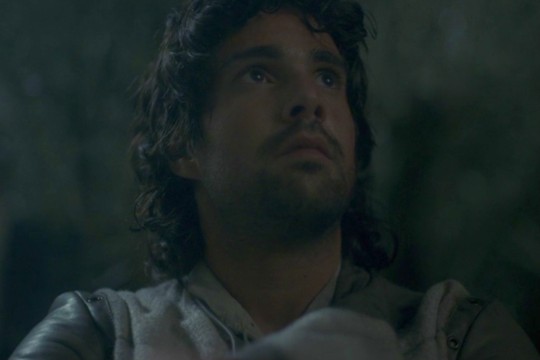
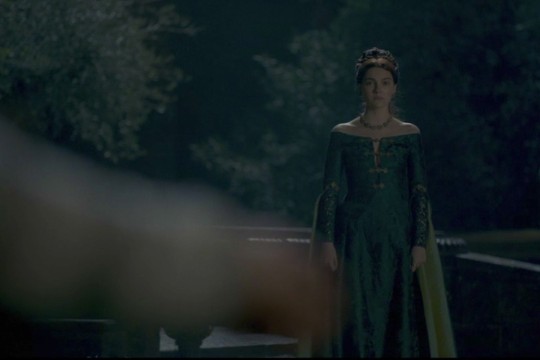




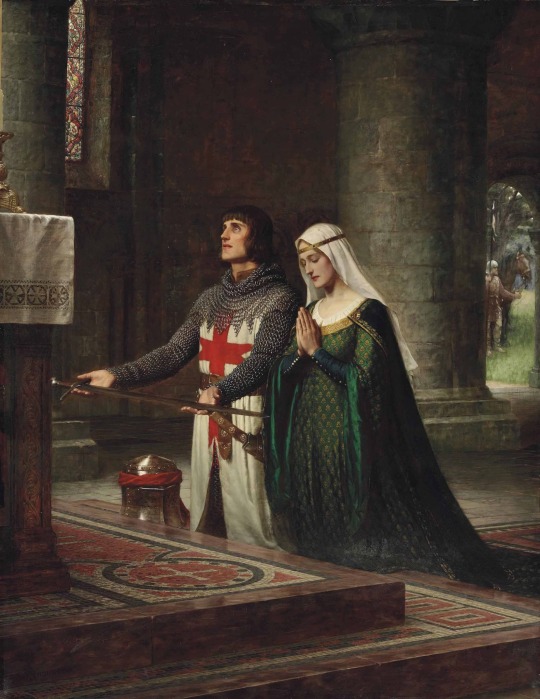






Ser Criston Cole and Queen Alicent Hightower in House of the Dragon
We’ll Never Have Sex - Leith Ross / The Art of Courtly Love - Andreas Capellanus tr. by John Jay Parry / Perfect Day - Lou Reed / The Dedication - Edmund Blair Leighton / John I Love You - Sinéad O’Connor / Prose Lancelot - Unknown tr. by Carleton W. Carroll / Idylls of the King - Alfred Tennyson
#to be clear i don’t like… ship them or whatever i just think their relationship is fascinating#i do think he ‘loves’ her but in a very strange obsessive way that can never be acted upon and is mostly just about making himself worthy of#the woman who gave him a second chance at life#i think she’s just glad to have someone who is devoted to her and who will stand up for her because most of the people in her life have#failed her spectacularly#it’s more about the idea of the other person than anything else#that being said i’m literally just making this all up based on the version of the characters that live in my head so… 🤷🏻♀️#parallels#web weaving#web weave#house of the dragon#hotd#alicent hightower#criston cole#alicent x criston#alicole#i guess
411 notes
·
View notes
Text
Writers who knew [Marie of France Countess of Champagne] depicted her in several guises. For Chrétien de Troyes, the most elusive of contemporary writers, she was an assertive patron of romances, dictating for example the subject and meaning of the Lancelot tale. The mischievous Andreas Capellanus, who was close to Marie in the mid-1180s, drew a highly entertaining parody of Marie and the prominent women of her milieu resolving the conundrums of amatory conduct in “courts of love,” in the manner of modern advice columnists. In Hugh of Oisy’s musical performance, Marie cut a fine figure as a combatant in a tournament of elite women. It is striking how in three quite distinctive imaginative works written in the 1180s, Marie appears as an author of an Arthurian romance, a judge at a court of love, and a participant in a tournament mêlée.
Others who knew Marie well in the 1180s and 1190s remarked different aspects of her character. The Eructavit poet noted her penchant for the trappings of wealth, and addressing her directly during a performance of his religious drama, chastised her for her “largesse and lavish expenses.” [Canon] Evrat, on the other hand, a resident canon of St-Étienne who observed Marie closely in the 1190s, stressed her spiritual and moral character. Seeking to understand the deep meaning of the scriptures, he wrote, she provided him a copy of Genesis to translate into the vernacular and annotate with the findings of the latest “academic” studies. In an epilogue added after her death, Evrat penned a eulogy praising her largesse and renown, and comparing her, la gentis contesse Marie, to the three biblical Marys—“she would be the fourth.”
An entirely different side of Marie was captured by Marie’s court stenographers, William (1181–87) and Theodoric (1190–97), who made verbatim transcripts of her comments and directives while observing her deal with the practical affairs of governance: assigning revenues (“I assigned 100s. on the entry tax on wine”), resolving disputes at court (“resolved in my presence in this manner”), confirming prior transactions (“I approved this act”), registering acts done at court (“done in my presence”), consenting to feudal alienations (“I approved because it was my fief”), founding chaplaincies (“for Geoffroy, count of Brittany, my brother”), and establishing endowments (“for the anniversary of my lord and husband, Count Henry”). All of that was “done in public,” usually in the presence of her officers and witnesses. It was precisely in her capacity as ruling countess of Champagne that she continued Henry the Liberal’s example of performing in public as prince of his principality. Having observed Henry at court���just as Henry, while a very young man, had observed the conduct of his father, which earned him the reputation as the “good” Count Thibaut—Marie understood that the comital court, as the core institution of the principality, demanded her active participation, and she paid close attention to the great and the minor issues presented there for her disposition.
It should be emphasized that Henry the Liberal’s principality was only three decades old when Marie became regent in 1181, and the primary comital residence and chapel in Troyes were barely twenty years old, not yet fully implanted as the seat of a new territorial state and mausoleum of a princely lineage. Marie’s task was to preserve the principality and its institutions intact, and to assure the continuity of the lineage. And that she did. Evrat sensed both the precarious nature of her rule and her achievement in holding a firm hand on the levers of comital authority, especially during those anomalous years of the 1190s: “Well did she protect and govern the land / letting nothing slip from her hand, / she was gracious, wise, valiant, and courageous.” By all accounts, Marie projected a complex, forceful, and captivating character, one that proved a worthy counterpart to the compelling personality of Henry the Liberal. [Canon Evrat rendered homage to her in the epilogue of his Genesis translation: 'She had the heart of a man and the body of a woman'].
-Theodore Evergates, "Marie of France Countess of Champagne, 1145-1198"
#historicwomendaily#Marie of France Countess of Champagne#marie of champagne#12th century#I love this a lot#not only because of what it tells us about Marie and how she was perceived#but also because it perfectly captures the elusiveness of these historical figures#and how our knowledge of them is so dependent on narratives and propaganda and secondary perspectives#also can I just say: Evergates summing her up as 'complex forceful and captivating'? FUCK YEAH#my post
10 notes
·
View notes
Text




The Art of Courtly Love: The Rules
31. "Nothing forbids one woman being loved by two men or one man by two women."
—Andreas Capellanus.
#final fantasy vii#clerith#zerith#cloti#final fantasy 7#ffviir#ffvii#ff7#ff7 remake#cloud strife#aerith gainsborough#zack fair#tifa lockhart#cloud x tifa#cloud x aerith#zack x aerith#edit#final fantasy edit#final fantasy 7 remake#gifs#ffedit
51 notes
·
View notes
Text
I ended up in a medieval rabbit hole researching some things about daily life to help me with writing fantasy-related fanfics, and I came across this interesting little tidbit:
Andreas Capellanus, a 12th century author of De Amore gives an insight into what dress accessories were available and could be given as a gift of love-
"A lover may freely accept from her beloved these things- a handkerchief, a hairband, a circlet of gold or silver, a brooch for the breast, a mirror, a belt, a purse, a lace for clothes, a comb, cuffs, gloves, a ring, a little box of scent, a portrait, toiletries, little vases, trays, a standard as a keepsake of the lover, and so to speak more generally, a woman may accept from her love whatever gift may be useful in the care of her person, or may look charming, or may remind her of her lover, providing, however, that in accepting the gift it is clear that she is acting quite without avarice."
Source
17 notes
·
View notes
Text
random info ♡
sometimes you really need just a tiny, random piece of info but you end falling into a rabbit hole about customs of ancent times



All the text under 'read more' in case someone is interested;
The life of a medieval knight
So, we know how to become a medieval knight, but what was the life of a medieval knight really like? The life of a medieval knight was centred around medieval castles or manors and fighting for his lord. The majority of a medieval knight’s life was spent perfecting his fighting skills and staying in good shape for battle.
The life of a medieval knight may have looked as follows:
The day started at dawn with a mass service, in which prayers would be said.
After this was the first meal of the day: breakfast.
Once they had eaten, knights would partake in weapons practice.
Next up on the schedule, were strategy meetings. During this time, knights would have discussions about warfare strategy and learn more about siege warfare and weapons.
Knights would now take part in mid-morning prayers and eat their second meal of the day.
As time went on, there was a greater emphasis placed on manners and chivalry. As such, knights were expected to learn the rules of the Code of Chivalry, which was a moral system that introduced the concept of chivalrous conduct. They would also be expected to learn the Art of Courtly Love, which was a 12th-century treatise written by the author, Andreas Capellanus. Knights may spend time learning dances during this time.
In the afternoons, knights would focus on their horsemanship. They would typically go riding with their lords, spending time hunting, hawking, or inspecting the estate.
When evening rolled around, it was time for another prayer service. This was followed by supper.
After this, the knights might have enjoyed some entertainment, in the form of music, dancing, jugglers, Jesters, etc.
The final step in the life of a medieval knight was bedtime prayers.

Knight facts for children
By the end of the Middle Ages, many countries had their own standing armies, which meant they no longer needed knights.
The word ‘knight’ comes from the word ‘servant’ in Old English.
Willian Marshal was one of England’s greatest knights - in 1217 and at the age of 70 years old, he defeated a French army which was invading Lincoln!
Knights followed a chivalric code which was influenced by Christianity.
Women could also be knights - the Order of the Hatchet in Catalonia was a military order of knighthood for women.
Knights were rewarded with land to own.
They had to be ready to fight whenever their King called on them.
A knight’s son would likely become a knight too.
Swords were designed to look like a cross as a reference to Christianity.
Knights held tournaments where they re-enacted battles. They could last hours or days!
#♡ random context facts#life of a medieval knight#this is about javier asrahan yes#i did my investigation#you can ask questions#im full of useless facts about knights and their ceremonies
3 notes
·
View notes
Text
From the woman who created Lancelot:

(From Epistolae. Found HERE)
"We declare and we hold as firmly established that love cannot exert its powers between two people who are married to each other" - Marie de Champagne
#arthuriana#arthurian legend#arthurian legends#arthurian mythology#king arthur#queen guinevere#sir lancelot#marie de champagne#chretien de troyes#andreas capellanus
15 notes
·
View notes
Text
still just blown away by the patronage career of Marie de Troyes (Countess of Champagne), who, in addition to sponsoring Chrétien de Troyes's writing of Lancelot, commissioned Andreus Capellanus to write a treatise on courtly love, in which she is a self(ish)-insert semi-fictionalized character giving direct advice on how to conduct love affairs, including "no it is not physically possible for married people to love each other," see this fictional letter that two fictional debators solicit from her:
The letter sent back by the Countess of Champagne "To the prudent and noble woman A. and the illustrious and famous Count G., M., Countess of Champagne, sends greeting. "Since we are bound to hear the just petitions of everybody, and since it is not seemly to deny our help to those who ask what is proper, especially when those who go wrong on questions of love ask to be set right by our decision — which is what the tenor of your letter indicates — we have tried diligently and carefully to carry this out without any extended delay. "Now you letter has shown that this is the doubt that has arisen between you: whether love can have any place between husband and wife and whether between lovers jealousy is blameworthy; in both questions each of you falls back on his own opinion which side properly should get the decision. We have therefore examined carefully the statements of both sides and we wish to end the case with this decision. We declare and we hold as firmly established that love cannot exert its powers between two people who are married to each other. For lovers give each other everything freely, under no compulsion of necessity, but married people are duty bound to give in to each other's desires and deny themselves to each other in nothing. Besides, how does it increase a husband's honor if after the manner of lovers he enjoys the embraces of his wife, since the worth of character of neither can be increased thereby, and they seem to have nothing more than they already had a right to do? And we say the same thing for still another reason, which is that a precept of love tells us that no woman, even if she is married, can be crowned with the reward of the King of Love unless she is seen to be enlisted in the service of Love himself outside the bonds of wedlock. But another rule of Love teaches that no one can be in love with two men. Rightly, therefore, Love cannot acknowledge any rights of his between husband and wife. But there is still another argument that seems to stand in the way of this, which is that between them there can be no true jealousy, and without it love may not exist, according to the rule of Love himself, which says, 'He who is not jealous cannot love.' "Therefore let this be our verdict, pronounced with great moderation and supported by the opinion of a great many ladies, be to you firm and indubitable truth. "The first day of May, in the year 1174, the seventh of the indiction."
— The Art of Courtly Love, by Andreas Capellanus, trans. John Jay Parry
6 notes
·
View notes
Text
It will be considered greatly to your credit if by your good sense you make a trained soldier of Love’s army out of me, who am now awkward and untaught. It is fitting that an awkward, untaught man should serve a lover by whose industry he may hide his heedless youth.
-Andreas Capellanus, The Art of Courtly Love
18 notes
·
View notes
Text
Eleanor of Aquitaine- Grandmother of Europe.
(part II)
Second Marriage
When Eleanor returned to Poitiers, Henry II duke of Normandy ordered his younger brothers to kidnap Eleanor and claim her lands, however that was not needed,because Eleanor herself sent a messenger telling Henry to marry her at once if he wanted. On May 18 1152 the couple married in secret. However, Henry and Eleanor were even more closely related, while her first marriage was annulled due to Consanguinity. Even more, A marriage between Henry and Eleanor's daughter Marie had earlier been declared impossible due to their status as third cousins once removed and now he was marrying the mother of the previous refused match. The reason for the secret marriage was that Eleanor’s choice for her second husband was a problem: as the rulers of French vassal states, Henry and Eleanor needed permission to marry from the king of France, and there was little chance that Louis was going to approve the marriage, besides Eleanor met Henry in 1151, well aware of his claims to English throne and his wealth, she took certain interests in him, later historians claim that as seed of divorce was already sprouting that time, so future couple came to an agreement that once she was divorced they would marry, that would explain why they started to act immediately after divorce. However, the source those historians mentioned from Eleanor's contemporary scribe did not survive.
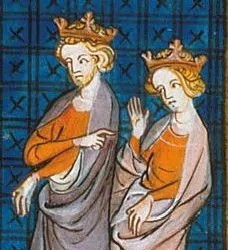
On October 25 1154 Henry became king of England and pregnant Eleanor was crowned queen on 19 December of the same year. On 28 February 1155 second child Henry the young was born, first child being William IX, Count of Poitiers. Over the next 13 years the coupe had 8 children, five sons and three daughters:
William (17 August 1153 – 1156)
Henry the Young King (28 February 1155 – 11 June 1183)
Matilda of England (June 1156 — June/July 1189)
Richard I (8 September 1157 – 6 April 1199)
Geoffrey II duke of Brittany ( 23 September 1158 – 19 August 1186)
Eleanor, queen of Castile (1161– 31 October 1214)
Joan queen of Sicily (October 1165 – 4 September 1199)
John Lackland (24 December 1166 – 19 October 1216)
Despite so many children Henry was by no means faithful of Eleanor and had numerous mistresses and illigitimate children. While Eleanor resented Henry's mistresses, she certainly had no hostility towards their children as when Geoffrey of York was acknowledged the Queen took him under her care.
Marriage has other problems as well, both parties were highly political, ambitious and stubborn. Aquitaine openly rejected the authority of Henry and declared that they would obey only the rightful duchess. After the third marriage and widowhood of Eleanor's first husband, marriage between "Young Henry" and Margaret of France was arranged,that is thought to be the last known co-operative decision of the couple,because after 6 following years of constant arguing,conflicts and power play, marriage was finally stained per Eleanor's discovery of Henry's affair with Rosamund the fair. Following the marriage of Matilda, third daughter of Henry and Eleanor, in 1167 Eleanor returned to Poitiers.
Court at Poitiers
While residing at her home, she hosted a legendary court. Most of the stories are just folklore and rumors, it is obvious that she was a great patron of art,poetry and literature. However, the famous "court of love" is mostly rumor. First of all, Courtly love was widely popular in France even before her birth,which I mentioned was the reason of her birth in the first place, therefore she could not have "invented" it as some mention. 12th century author Andreas Capellanus, a famous admirer of love of his time, mentions how Eleanor and her daughter Marie, listened to young lovers, acted as jury and supporting love out of wedlock as heartbroken queen rejected the coexistence of love and marriage. However, this is pure fiction created by Capellanus,as Marie and Eleanor did not spend that much time together, but it's based on Eleanor's actual support of teaching manners and kind of creating "etiquette" regarding treatment of spouses.All that can be said is that her court at Poitiers was most likely a catalyst for the increased popularity of courtly love literature in the Western European regions.

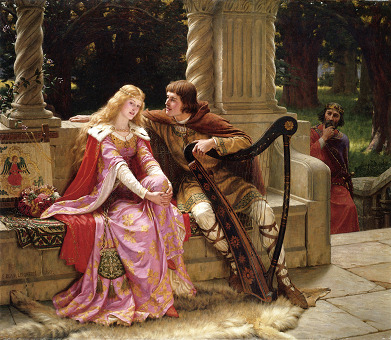
Different paintings inspired by the court of love.
Involments in Rebellion (1173-1174)
In 1173 the young Henry(junior king of England from 1170) started the Rebellion against his father, which Eleanor supported. The young king went to Aquitaine where Eleanor and his two younger brothers Geoffrey and Richard resided. Contemporary historian Roger of Hoveden claims that the queen sent her younger sons to France "to join with him[Henry the young] against their father the king."Once her sons had left for Paris, Eleanor encouraged the lords of the south to rise up and support them. In 1174 Eleanor herself left Aquitaine,but was captured and imprisoned by her husband. Young Henry was pardoned as, likely due to the involvement of Eleanor and Henry himself not wanting to punish sons, blame was put on barons,who were punished for manipulating young prices to do the evil deed.
Imprisonment
From 1174 to 1189 Eleanor spent her life as a prisoner. She was put under the house arrest in various English palaces,where she was under supervision of the king. She was permitted to see her sons only during special occasions, namely Christmas. That is the time she grew particularly estranged to her husband and favourite son Richard. During the first nine years of imprisonment she was minimally active in politics, but when King's mistress Rosamund the fair suddenly died in 1176 under quite mysterious circumstances, rumors rose that it was Eleanor who arranged her death by poisoning. Legend has it that Eleanor sneaked into her rooms and offered her to die either by dagger or by poison, which she eventually chose. Other legends say that she was roasted alive between two fires or her arms were cut off in the bath. However, all of them appear either in the 14th century's "French chronicles of london" or during Elizabethan era tales and balades, so they can not be true, however considering no recorded disease or accident around Rosamund,it seems quite sensible that Eleanor, who had certain freedom, could have bribed one of Henry's servant to poison her. The theory is the oldest, appears in the early 13th century, little time after Eleanor's death. It's justified by Rosamund's fault in estranging the couple and Henry's supposed plans to use Rosamund to force Eleanor into divorce. What really happened is unknown and the incident was quickly forgotten.
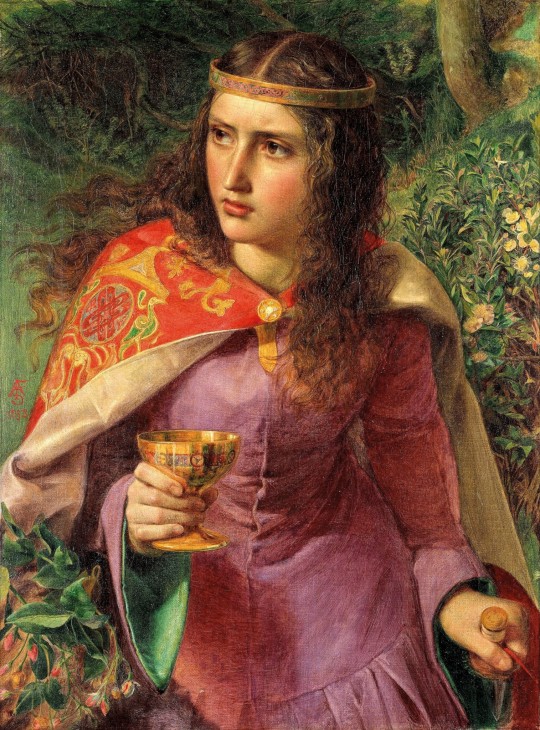
Queen Eleanor as depicted by Frederick Sandys. We can see her carrying a bowl of poison and a dagger.
On Saturday, 11 June 1183, the young king realized he was dying and was overcome with remorse for his sins. When his father's ring was sent to him, he begged that his father would show mercy to his mother, and that all his companions would plead with Henry to set her free. So Eleanor was set free and permeated to see her son one last time.Her major rise to power started in 1183 when Philip of France demanded lands in Normandy,which was the property of deceased young Henry. However, lands in Normandy was Eleanor's prior passing it to son, so after his death it should have been returned to her, as a result, Henry summoned Eleanor and sent her to Normandy, where she spent several months,but returned to England in 1184, after that she was technically free,but under supervision. She would often accompany her husband and even took part in deciding some political affairs. Upon the death of her husband Henry II on 6 July 1189, Richard I succeeded, One of his first acts as king was to send William Marshal to England with orders to release Eleanor from prison. During widowhood she gained power she never had before.
The Queen mother
After her release Eleanor rode to Westminster and received the oaths of fealty from many lords and prelates on behalf of the king. She would then act as regent for her son,who was fighting long wars. On 13 August 1189, Richard left for Portsmouth. Later he was absent from 1190 to 1194 for crusades and later was in captivity of the holy Roman emperor. During that time Eleanor was an unofficial regent, overseeing any decisions made by council and even went to Austria to personally arrange the release of her son. Her influence is evident by letters to the Pope,the holy Roman emperor and the king of Castile. Richard died in 1199 and Eleanor then became a major force in the reign of John Lackland.under the terms of a truce between King Philip II and King John, it was agreed that Philip's 12-year-old heir-apparent Louis would be married to one of John's nieces, daughters of his sister Eleanor of England, queen of Castile. Eleanor, who was 77-78 that time, herself went to Castile to choose one of the princesses. Same year she was kidnapped by Hugh IX of Lusingan.(that was not the first and last attempt of kidnapping her, actually it was the third out of four known occasion), she however arranged her freedom herself. In Castile, she remained for two months and returned to England after choosing Blache as the bride. The trip is said to affect her health.

Despite reducing health and increasing age, intrigues were not ending in her life, the war broke between John and Arthur the son of Eleanor's second son Geoffrey. The reason for the conflict was the succession to the English throne. After Richard I died without an heir, the throne was supposed to pass to the following brother Geoffrey,who died before Richard,but had a posthanous son Arthur,who was heir over John. Eleanor however supported the claim of John, as a reason very familiar instance of her life took place, she was kidnapped...again. After negotiations she was released with the condition that she would withdraw from politics and go to nunnery(which could have been her own choice). She died soon after in 1204 and was buried with her second husband in Fontevraud abbey.
one of many of her achievements I would like to underline the most is her age. after giving birth to 10 child in 12th century,being imprisoned for 9 years in castle, went to crusades, traveled in Austria and castle in her late 70's, she still managed to live up until 82 years, almost twice as much as avarage lifespan of her time.
My next post is going to be about women in the Ottoman empire so...
7 notes
·
View notes
Text
“Queen Anne Boleyn (~1507-1536) failed to meet social norms during her time as Queen Consort to Henry VIII (1491-1548). By tracing concepts of queenship through the works of Chrétien de Troyes, Andreas Capellanus, Thomas Malory, and Juan Luis Vives this thesis demonstrates how Anne united the office of queen and mistress to bring her downfall and introduce a new construct of queenship.”
— Heather R. Geiter, Imagery and Objectification: A Study of Early Modern Queenship (MA Thesis)
10 notes
·
View notes